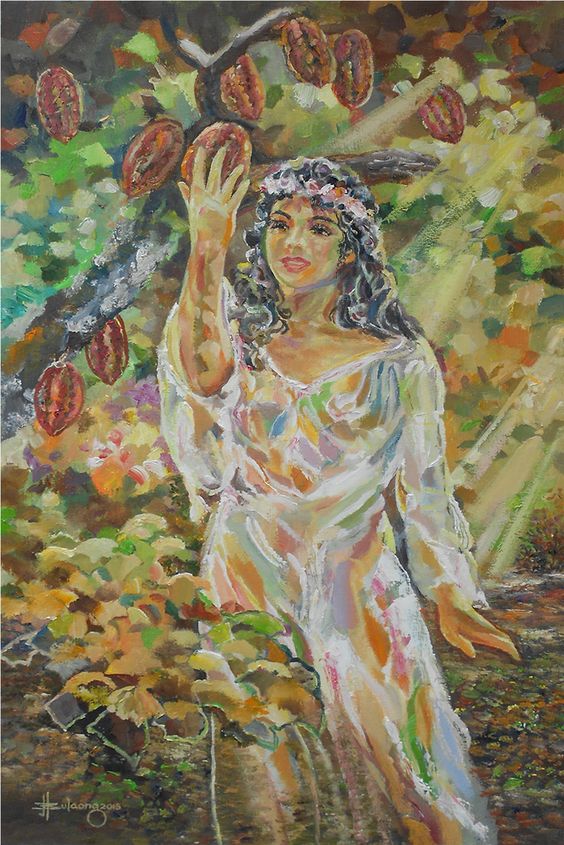
Maria Cacao is a mountain goddess Image Source: Maria Cacao (Philippine Legend) - oil on canvas 16" x 24" by JBulaong 2015
Did you know that there is a diwata (fairy or goddess) that is associated with cacao?
Her name is Maria Cacao or Kakaw, the diwata of Mount Lantoy from Argao, Cebu [1]. Some may be more familiar with her counterparts in other places of the archipelago, Maria Makiling of Laguna and Maria Sinukuan of Pampanga. They are sometimes called the Three Marias as the three widely known mountain goddesses in the country.

The town of Argao, Cebu is located at the southern part of the island.
In Filipino culture, regardless of where you were born, there is some sort of familiarity with local folklore, the Kapre (a type of giant) that lives in the trees or even the diwata that would make you lost in the mountain forests. Myths, legends and folktales are stories passed down through generations, some of them explaining how certain things came to be, or to deliver a valuable lesson.
Argao, Cebu is known to be home to cacao and one of the finest sikwate in the country. So, it is not surprising that the mountain goddess of the area has adapted it as part of its name. The legend goes as follows [2]:
On the highest mountain of Argao, in the cave of Lantoy, there lived a very beautiful woman called Maria Cacao. According to the old folks, she was a fairy who would sometimes come down and show herself to the townspeople when the moon was full.
She was called Maria Cacao after her huge cacao plantation on the mountain. In fact, she would sometimes travel to America to sell her cacao.
From her travels, Maria Cacao usually brought new utensils, silverware, and chinaware. The townspeople used to borrow these items for weddings, baptisms, and other feasts. It is said that anyone who wished to use Maria Cacao's things simply asked for them at the mouth of the cave. Next day, without fail, these things would be delivered to his door.
For her trips, Maria Cacao used a huge golden ship. Because of its size, sometimes its mast would snag on the bridge of Argao so that the bridge would collapse.
When the Americans were about to build a concrete bridge in Argao, the people said to one another: "The new bridge will have to be very high so that the golden ship of Maria Cacao cannot touch it."
One day, an engineer went to Maria Cacao's cave and begged her not to pass by the Argao river so the bridge would not be destroyed again. Maria Cacao is said to have agreed. Hence, nothing has happened to the bridge of Argao.
However, the people cannot borrow utensils for their feasts any more. Nor have they seen Maria Cacao. It is said that Maria Cacao has learned a lesson. Some townspeople failed to return things borrowed from her; thus, Maria Cacao no longer appears to the townspeople.
Sometimes, when the townspeople hear that the bridge of Dalaguete, Manipis, or Mananga is destroyed, they say: "It may be due to the golden ship of Maria Cacao. Now she has probably moved to another place and has to pass by another river."
In some versions that was passed on, she is even related to another folk creature in the area, Mangao or Mangaw, who is often referred to as a husband or a suitor [1]. He is believed to have resided in the cave opposite Maria Cacao, the Balay sa Agta (Home of the Giant Cave). In some versions, they reside in the same cave.
Isn’t the tale interesting? Maria Cacao seems to have been a prolific trader of cacao, which is fitting for the town of Argao, known for its rich cacao culture. According to Alburo [1], it is likely that the tale originated from an older form of a goddess in a golden boat ship and has adapted cacao to its name once the crop was introduced to the area.
In fact, Alburo even explained that the origin of the legend with the boat motif may even be from Dalaguete, Cebu and has later evolved to combine with another tale pertaining to a lender as the people of the town migrated to surrounding places, bringing the story with them. The elusive diwata has even more interesting variations in these areas [3]. In some, she is known to kidnap people to keep as her servants if she finds them out at night. She is even known to host parties in her golden boat with other encantadas (enchanters) where they watch the destruction of the local bridge as they pass it. In others, she is a militant leader of an enchanted naval army who bombs the local river bridge that is made through the forced labour of Filipinos by our colonizers. There’s even a version where she has a giant shrimp as a pet!
This only demonstrates the evolution of our folktales, reflecting our perception of the times and adjusting to the present conditions of our environment. In recent years, there are even revivals of the Maria Cacao tales where sightings of her golden boat were presumably spotted during Typhoon Sendong and Haiyan [4]. They claim she invites those stranded in the typhoon onto the boat, but in doing so, takes their souls to the next world, echoing tales of ships for the dead.
We think that the Maria Cacao folktale is an incredible story to uncover. Her stories explore our culture of migration, giving, and a way to remember our history. To us, as a local tree-to-bar chocolate company, her tale is an incredible symbol of our long history with cacao and how it has become a staple part of our tradition and culture. It is even inspiring to know that in the prominent version of the tales, she is known to have sold the crop overseas for the sustenance of the town she resides in.
We hope delving into this story was as enjoyable to you as it has been for us! Let’s continue to tell the story of Maria Cacao to the next generations, better told over a cup of hot sikwate.
[1] Alburo, Erlinda Kintanar. (1980). A Study Of Two Cebuano Legends: The Lost Lender And Maria Cacao. Philippine Quarterly of Culture and Society, 8:44-59. [2] Alburo, E.K. (1977). Cebuano Folktales 1. Cebu City: San Carlos Publications. [3] Seki, K. (2001). Rethinking Maria Cacao: Legend-making in the Visayan Context. Philippine Studies, 49:560-583 [4] Tan, M. (2016, April 15). Maria Cacao. Retrieved from The Inquirer on April 2022, from https://opinion.inquirer.net/94297/maria-cacao [5] Bulaong, J. (2015). Maria Cacao (Philippine Legend) [oil on canvas 16" x 24"]. Retrieved on July 2022, from https://pin.it/5aLujap
Article by: Ira Mendez, Community Development Officer
 Auro PH
Auro PH
 Auro BH
Auro BH
 Auro JP
Auro JP
 Auro TW
Auro TW

